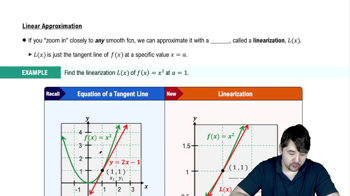Table of contents
- 0. Functions7h 52m
- Introduction to Functions16m
- Piecewise Functions10m
- Properties of Functions9m
- Common Functions1h 8m
- Transformations5m
- Combining Functions27m
- Exponent rules32m
- Exponential Functions28m
- Logarithmic Functions24m
- Properties of Logarithms34m
- Exponential & Logarithmic Equations35m
- Introduction to Trigonometric Functions38m
- Graphs of Trigonometric Functions44m
- Trigonometric Identities47m
- Inverse Trigonometric Functions48m
- 1. Limits and Continuity2h 2m
- 2. Intro to Derivatives1h 33m
- 3. Techniques of Differentiation3h 18m
- 4. Applications of Derivatives2h 38m
- 5. Graphical Applications of Derivatives6h 2m
- 6. Derivatives of Inverse, Exponential, & Logarithmic Functions2h 37m
- 7. Antiderivatives & Indefinite Integrals1h 26m
- 8. Definite Integrals4h 44m
- 9. Graphical Applications of Integrals2h 27m
- 10. Physics Applications of Integrals 2h 22m
4. Applications of Derivatives
Linearization
Problem 4.R.49
Textbook Question
Change in elevation The elevation h (in feet above the ground) of a stone dropped from a height of 1000 ft is modeled by the equation h(t) = 1000 - 16t², where t is measured in seconds and air resistance is neglected. Approximate the change in elevation over the interval 5 ≤ t ≤ 5.7 (recall that Δh ≈ h' (a) Δt).
 Verified step by step guidance
Verified step by step guidance1
Identify the function that models the elevation: h(t) = 1000 - 16t².
Determine the derivative of the function h(t) with respect to t to find h'(t). The derivative h'(t) represents the rate of change of elevation with respect to time.
Calculate h'(t) by differentiating h(t) = 1000 - 16t². The derivative is h'(t) = -32t.
Choose a point 'a' within the interval 5 ≤ t ≤ 5.7 to approximate the change in elevation. A common choice is the midpoint of the interval, t = 5.35.
Use the formula Δh ≈ h'(a) Δt to approximate the change in elevation, where Δt = 5.7 - 5. Substitute a = 5.35 and Δt = 0.7 into the formula to find the approximate change in elevation.
 Verified video answer for a similar problem:
Verified video answer for a similar problem:This video solution was recommended by our tutors as helpful for the problem above
Video duration:
3mPlay a video:
Was this helpful?
Key Concepts
Here are the essential concepts you must grasp in order to answer the question correctly.
Derivative
The derivative of a function measures the rate at which the function's value changes as its input changes. In this context, h'(t) represents the instantaneous rate of change of elevation with respect to time, which is crucial for understanding how quickly the stone is falling at any given moment.
Recommended video:

Derivatives
Change in Function Value
The change in function value, denoted as Δh, refers to the difference in the function's output over a specified interval. In this case, it represents the change in elevation of the stone as time progresses from t = 5 to t = 5.7 seconds, which can be approximated using the derivative and the change in time, Δt.
Recommended video:

Average Value of a Function
Interval Notation
Interval notation is a mathematical notation used to represent a range of values. Here, the interval 5 ≤ t ≤ 5.7 indicates the specific time frame during which we are analyzing the stone's elevation, allowing us to focus on the behavior of the function h(t) within that range.
Recommended video:

Sigma Notation
Related Videos
Related Practice




